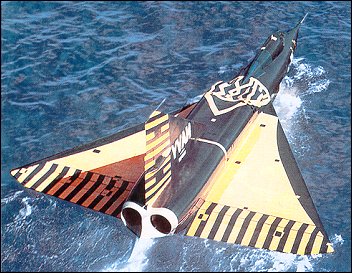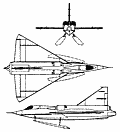 |
Convair XF2Y-1 Sea Dart1953 |  |
| EXPERIMENTAL SEAPLANE | Virtual Aircraft Museum / USA / Convair |
 |
One of the most unusual single-seat fighters to be developed during the early years following World War II, the water-based Convair Sea Dart had a blended hull mounting delta wings and large vertical tail surfaces. For take-off and landing it had extendable hydro-skis; these produced sufficient hydrodynamic lift during the take-off run to raise the hull clear of the water, the Sea Dart then aquaplaning on the skis until flying speed was attained. The concept embodied in the Convair Model 2-2 proposal was sufficiently interesting for the US Navy to award a contract for a prototype XF2Y-1 on 19 January 1951, followed by an order for 12 production F2Y-1 fighters on 28 August 1952; to this was added subsequently four YF2Y-1 pre-production aircraft. First flown on 9 April 1953, the prototype offered performance much below expectations and this factor, coupled with serious vibration problems with the hydro-skis, led to the XF2Y-1 and the production F2Y-1s being cancelled. More power was needed than the 1542kg thrust provided by each of the Westinghouse J34-WE-32 turbojets installed in the prototype and the first YF2Y-1. This latter aircraft was re-engined with two J46-WE-2s, the rear fuselage being modified to accommodate the engine afterburners and the same powerplant was installed in the remaining three YF2Y-1s. On 3 August 1954 the YF2Y-1 exceeded a speed of Mach 1 in a shallow dive, the first seaplane to become supersonic, but only two of these aircraft were used in a limited test programme that was terminated finally during 1956. FACTS AND FIGURES © It was intended that a production version would have armament of 20mm cannon and a pack of unguided rockers. © Problems with vibration during water operations saw a variety of multiple and single ski and skid arrangements tested. No totally satisfactory solution was found. © The Sea Dart took off on a pair of retractable hydro-skis, one on each side of the hull. These moved between three positions during the take-off run. © The dive brakes in the lower rear fuselage doubled as water brakes and a water rudder when floating.

|  COMPANY PROFILE | |||||||||||||||||||||||||||||||||||||||||||||||||||||||||
 |

|

